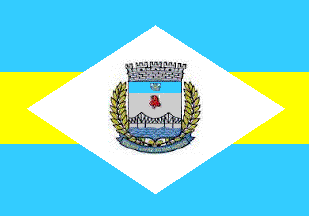 image by Blas Delgado Ortiz
and Ivan Sache, 4 January 2013
image by Blas Delgado Ortiz
and Ivan Sache, 4 January 2013
Last modified: 2013-02-02 by ian macdonald
Keywords: sao paulo | sao jose do rio pardo | lozenge (white) |
Links: FOTW homepage |
search |
disclaimer and copyright |
write us |
mirrors
 image by Blas Delgado Ortiz
and Ivan Sache, 4 January 2013
image by Blas Delgado Ortiz
and Ivan Sache, 4 January 2013
Source:
http://www2.rantac.com.br/users/hfontao/simbolos.htm. Coat of arms and information
in Portugese at the same page.
Dov Gutterman, 7 February 1999
From this site:
"[The flag was] created by municipal law no. 494 of 23 June 1966. Professor Paulo Caio de Araújo Leme was the winner of a competition conducted by the municipal executive. The rectangle is divided into three [horizontal] stripes; the central stripe symbolizes the Pardo River that passes through the city. The municipal coat of arms in the center of the lozenge acknowledges the importance of São José do Rio Pardo. The colors of the flag symbolize:Translated by Jorge Candeias, 8 February 1999The municipal coat of arms was also [approved?] by law no. 493 of 23 June 1966.
- blue: the color of infinity, the spiritual richness of the people, the love of truth and wisdom.
- yellow: the riches of the municipality (onions, cork, rice and other cereals), as well as the other economical aspects.
- white: the peace that has always reigned in our city, and the purity of its people..
The municipality of São José de Rio Pardo (51,910 inhabitants in 2010; 41,902 ha) is located 260 km of São Paulo.
São José de Rio Pardo originates in the chapel of São José do Rio Pardo, founded on 30 March 1873 by Colonel Antônio Marçal Nogueira de Barros. The municipality of São José de Rio Pardo was established by Law no. 49 of 20 March 1885 and inaugurated on 8 May 1886.
Photos of the flag
http://gazetadoriopardo.com.br/vnoticias/976/Escola+Stella+Couvert+chega+aos+45+anos.html
http://portalriopardo.com/esporte/06-08-2012/escolas-stella-couvert-e-joao-gabriel-ribeiro-dao-inicio-as-partidas-do-j-o-s-e-2012-portalriopardo
The bridge "Eucldides da Cunha", represented on the coat of arms, is
the emblem of the town. Its building was initiated by a Bill tabled on
28 June 1892 by Senators Ricardo Batista, Antônio Mercado and Silva
Pinto Júnior, arguing that "the relations of São José with Minas
Gerais are loose without an adequate, unique metallic bridge". The Law
allowing the government to build the bridge was adopted on 4 August
1892. The profile of the bridge was drafted in 1896 by the engineer
Heitor Georgotich; the building started in May-June 1896, directed by
engineer Arthur Pio Deschamps de Montmorency. The metallic bridge was
imported from Germany. Inaugurated on 3 December 1898, the bridge
collapsed 50 days later, on 23 January 1898.
The bridge was rebuilt by the engineer and writer Euclides da Cunha,
60 m upstream from the first bridge, and inaugurated on 18 May 1901.
The bridge was fully revamped in 1985 and reopened on 28 December
1985. The bridge "Euclides da Cunha" was registered as an Historical
Heritage on 8 May 1986.
http://www.saojoseonline.com.br/euclides/coponte.htm
Euclides da Cunha supervized the building from the "zinc hut", where
he also wrote his most famous book, "Os Sertões"; the hut was
proclaimed a National Monument by Federal Decree-Law no. 25 of 30
November 1937. The house where he lived at the time was renamed "Casa
Euclidiana" (Euclides' House) by State Decree-Law No. 15,961 of 14
August 1948. The writer is celebrated every year during the "Semana
Euclidiana" (Euclides' Week) organized since 1912; in 1925, the
Municipal Council proclaimed the 15th of August "Dia de
Euclides" (Euclides' Day). In 1982, the remains of Euclides da Cunha
and of his son Euclides da Cunha Filho were officially repatriated
from Rio de Janeiro to São José de Rio Pardo and buried in a mausoleum.
http://berrante.orgfree.com/Semana_Euclidiana/sesjrp.htm
Ivan Sache, 4 January 2013